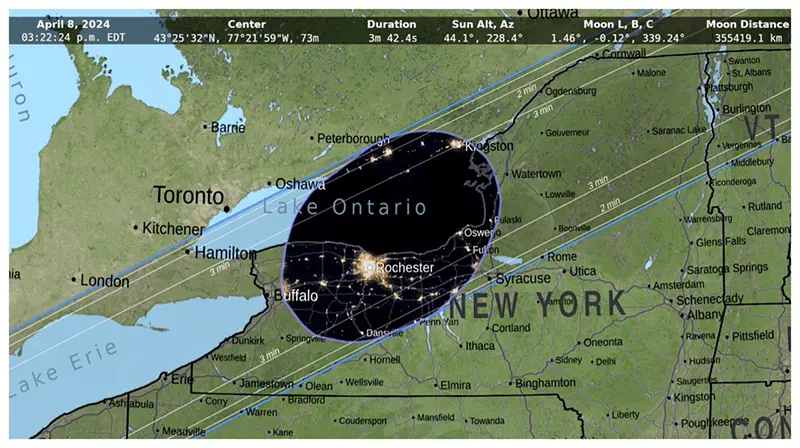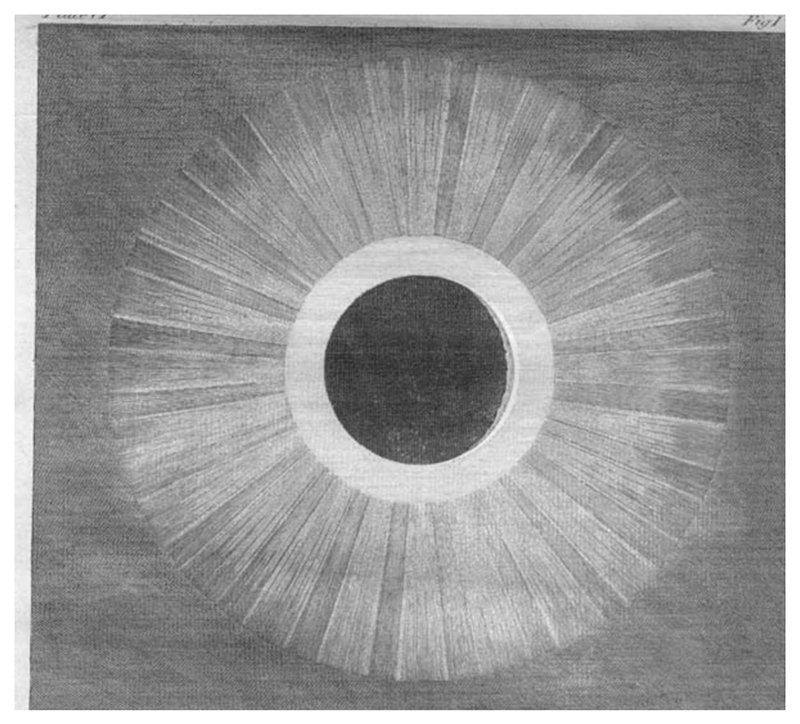NewsletterMarch 8, 2024
T-minus 1 month: Our Solar Eclipses in History
It is exactly 1 month until the total solar eclipse in Geneva! Let’s talk about the history of solar eclipses in our region and what makes them special.
A total solar eclipse occurs somewhere on Earth about every 18 months, but because the apparent sizes of the Sun and the moon in the sky are so closely matched, the region on the Earth directly beneath the circular Moon’s shadow is only about 100 miles across. In addition, as the moon moves in its tilted orbit and the curved Earth rotates underneath it, the shadow passes over a single location on Earth, like Geneva, N.Y., at over 1,000 mph completely blocking the Sun’s light for only a few minutes at most. For these reasons, a total solar eclipse is an ephemeral and rare event at a specific location.

Indeed, over the past 1,000 years, there have been only five total solar eclipses that have passed directly over Geneva. The first was in August 1142. A few scholars have argued that this eclipse was the ‘sign in the sky’ referred to in the Haudenosaunee oral history that led to the final ratification of the Great Law of Peace by the Senecas, which ultimately created the Iroquois Confederacy. Over 200 years later, two winter total solar eclipses occurred within 50 years of each other in December 1349 and then January 1395, and then for the next 400 years only partial or annular eclipses (in which the moon passes directly in front of the Sun, but its apparent size in the sky is not big enough to completely block the Sun’s light) were visible to an ancestor living in this area before the Great American Eclipse of the 19th century happened in 1806.
On June 16, 1806 a total solar eclipse crossed the United States from southern California to New England cutting right across the Finger Lakes. At 10:57 a.m., the moon’s shadow passed directly over Geneva, N.Y., blocking the Sun for 3 minutes and 42 seconds. This eclipse was described in detail by James Fenimore Cooper who was visiting his family in Cooperstown, N.Y., at the time.
"At twelve minutes past eleven, the moon stood revealed in its greatest distinctness — a vast black orb, so nearly obscuring the sun that the face of the great luminary was entirely and absolutely darkened, though a corona of rays of light appeared beyond. The gloom of night was upon us. A breathless intensity of interest was felt by all."
--James Fenimore Cooper
"The Eclipse."
Ninety miles away in Kinderhook, N.Y., the Spanish astronomer José Joaquin de Ferrer made a dazzling drawing of the Sun’s corona – which, at the time, could only be studied during total solar eclipses. He established through its large extent that it must be an outer layer of the Sun (and not a phenomena of the moon).

Drawing of the total solar eclipse of 1806 by Spanish astronomer Don José Joaquín de Ferrer from Kinderhook, N.Y.
Finally, in January 1925, our fifth total solar eclipse opportunity in the past 1,000 years was afforded us in Geneva, N.Y., but the weather was uncooperative. Fifteen minutes before totality, the Sun entered a dark bank of clouds. "Then the clouds became thicker and thicker until they blotted out the Sun entirely." By the time the clouds cleared, the moment of totality had long ended. Check out the whole story of this day compiled by Archivist and Special Collections Librarian Brandon Moblo. Let’s hope for better weather on our upcoming 2024 eclipse!
As totality approaches around 3:20 p.m. in the afternoon of April 8, the temperature will drop, the sky will darken until the brightest stars and planets become visible in the afternoon sky, and the partially eclipsed Sun will create unusual shadows on the ground. When the last rays of the Sun are no longer able to peak through the deepest valleys on the lunar surface, the black disk of the moon will replace the Sun’s shining face leaving the moon with a crown of streaming light. This crown is actually the Sun’s corona, a super-heated plasma two million degrees in temperature, that is visible only during a total eclipse when the light from the Sun’s surface can’t overwhelm it.
Don’t miss this unique event on April 8!
Click here for complete details on HWS’ plans for observing the eclipse on campus.
